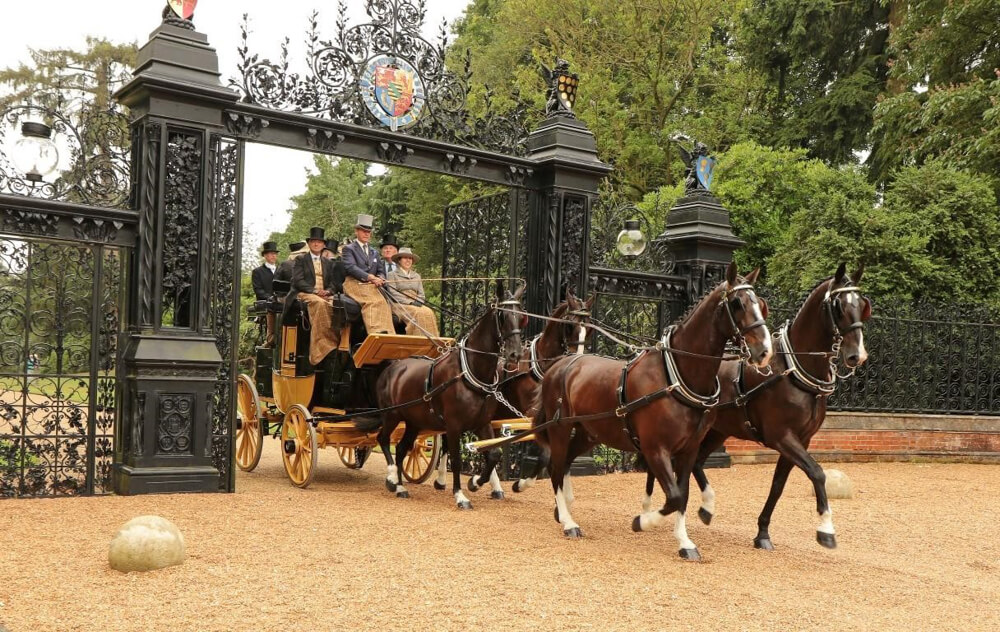26 June 2018
Sandringham 2018: A celebration of Carriagedriving
Since its inaugural Event in 1982 Sandringham has organised an annual Horse Driving Trials. The date of the event always followed the week after Royal Ascot. This date was also either before or after the Royal Norfolk Show. In 2017 the event was expanded to include the majestic Coaching Club and the elegant Concours d'Internationale d'Attelage de Tradition event. Both groups complimented the Driving Trials, greatly enjoying the wonderful countryside of the Sandringham Estate, so much so that in 2018 both groups are back, with greater numbers expected.Keeping the Coaching tradition alive
The Coaching Club was formed in 1871 on the instigation of Lt Col Henry Armytage, and originally consisted of 50 members. The reason for its formation was that the four in hand Club, established in 1856 was limited in membership and it was desired to form an overflow driving Club to meet the growing enthusiasm for Coaching; for those wanting to keep the traditions of four in hand driving alive since the demise of the skills due to the advent of the railways and then the motor car.
The first President was the His Grace the 8th Duke of Beaufort, who held office until 1897. At the first meet on 25th June 1872, 21 coached turned out, and the record attendance was at the meet held on 2nd June, 1894, when 39 coaches paraded.
The Club livery and colours were established since the inception of the Club, and permission to wear them was granted by the first President, The Duke of Beaufort, his hunting colours, blue coat and buff waistcoat. Reference was made in 1872 to “the wearers of the blue and buff”. The practice of members wearing button-holes of cornflowers dates back from the 2nd meet of the Club, and has been a tradition ever since.
The current President of the Coaching Club is Mark Broadbent; who instigated the meet at Sandringham in 2017; and due to its success and popularity, it is becoming an established event in the Coaching Club calendar. Mark is keen to expand the meets and awareness of the Coaching Club, and The Presidents meet at Sandringham is the first of new meets in addition to the Clubs traditionally established meets at Windsor and London. The keeping of traditions and high standard of turnout is number one priority for the President, and this will be evident at Sandringham.

Mark Broadbent driving through the Sandringham Gates
Promoting the art of Traditional Carriage Driving
AIAT GB (Association Internationale d’Attelage de Tradition) will be holding it’s second CIAT Sandringham competition again this year at the Sandringham Estate. Organiser Rosemary Neale states “we are thrilled to be invited back to this magnificent venue and allow the wondrous variety of traditional carriages the opportunity to drive around the estate”.
The competition is open to any traditional carriage for any equine including Donkeys, Mules, Ponies and Horses. “Although the competition runs over three phases, we have separate categories for traditional carriages that include the wide plethora from small Pony Gigs, Market Carts, Park Phaetons, Brakes, Coaches to trade vehicles.” Carriages built before 1945 are eligible for higher scores at presentation to encourage and promote their use.
The competition was originally created to encourage the use old vehicles that were and are suffering from lack of popularity and destruction in favour of modern sporting vehicles. “Last year we were thrilled to see such a wide variety of turnouts compete in this unique competition format”. A lot of newcomers exclaimed at the relaxed friendly atmosphere and wonderful socialising, it was a refreshing change from the norm and are keen to do more”
The competition starts with a standing presentation where participants will be judged separately three times by the international AIAT judges. Close attention to detail and correctness of turnout will be observed. A formal dinner follows that evening where participants, sponsors and volunteer helpers get the chance to socialise.
Ridden Trec
Trec originated in France as a way of testing and improving the skills of trail ride leaders, and was introduced into the UK in the early 1990s. It is now a very popular equestrian sport, in this country, intending to test the skills of horse and rider in planning and executing a long distance ride in unfamiliar country. It is a very friendly and sociable sport, competitors either compete as an individual or in pairs, and camp, with their horses corralled over the weekend.
Any rider and horse/pony can take part in Trec, whether you want to aim for the national championships, at the end of the ‘summer’ season, or just enjoy hacking in a different area – with a bit of orienteering to tackle. Trec competitions are run throughout the summer months, usually over a weekend, with up to 4 different levels competing.
It is a three phase competition, the POR, the PTV and MA. Usually the POR – Parcours d’Orientation et de Regularite – orienteering ride takes place on the first day. Depending on the level at which you are competing, distance covered range from 15km long to 40km, and riders loose points, (each competitor starts with 240 points) for using an incorrect route, or riding too fast or slow, between check points. At the higher levels riders may have to navigate using grid references or compass bearings only.
The PTV – Parcours en Terrain Varie – the obstacle phase and the MA -Maitrise Des Allures – control of paces, take place on the second day. The MA is ridden in a corridor up to 150 m long. You have to canter down it as slowly as possible, then turn around and walk back as fast as possible without leaving the corridor or breaking pace. Points ( out of a maximum of 60) are determined by the time taken for each pace. The PTV is a course of 16 obstacles, following a timed route that can cover up to 5km, over natural terrain.
The obstacles are to test the skill and partnership of horse and rider, and are meant to simulate ‘difficulties’ you find when hacking out, these vary from water crossings, narrow corridors to ride through or back up, inclines/declines, gates, log jumps, ditches, mounting etc. Each obstacle is judged and marked out of 10. At the end of the competition the points gained in each phase by each rider are added up and the highest total wins.
Trec competitions take place all over the UK, during the summer months. One weekend you can be competing in the Welsh mountains and the next in the Lincolnshire Wolds. We are very fortunate to be able to come and compete at the Sandringham Estate and look forward to its fantastic countryside and woods. If you would like to enter the Sandringham Event or want any information about Trec please go to TrecGB website.






